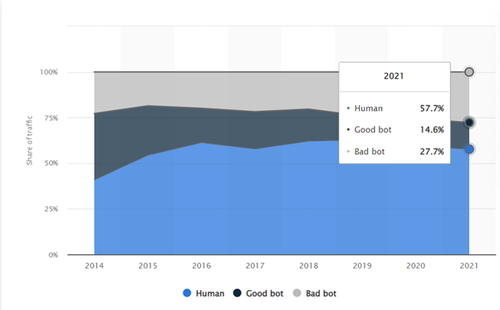42% of Internet Traffic is from Bots – What is Your Cybersecurity Gameplan?
Bots are multiplying, and 42% of internet traffic comes from bots, and they’re getting smarter. The bad news is bad bots are getting smart, and their activity rate is higher than good ones.
August 22, 2022

Vinugayathri Chinnasamy, Senior Content Writer, Idusface
Bots are multiplying, and 42% of internet traffic comes from bots, and they’re getting smarter. The bad news is bad bots are getting smart, and their activity rate is higher than good ones.
Figure 1: 
Image Source: Statista
Today’s modern bots can circumvent detection with machine vision technology. They’re not mitigated by rate limiting, traditional rules in Web Application Firewalls (WAF), or IP reputation databases necessitating the adoption of a comprehensive bot protection solution .
Bots are Getting Smarter. That’s Creating Tricky
Today, bot attacks are no longer limited to spamming or small scarping attempts. Bots help attackers perform DDoS attacks, take over accounts, perpetrate credit card fraud, abuse APIs, and more.
In the past, security systems were able to detect malicious bot activities – most bot attacks created unnatural spikes in traffic, and the spike appeared quite different from legitimate traffic. In most cases, bad bot traffic creates sharp surges during holidays, weekends, and other times when human traffic is less likely to appear. By identifying these anomalies, the security system instantly flagged bot traffic when the malicious activity began.
Today’s sophisticated bot attacks mimic actual human legitimate traffic patterns. According to Arkose Labs, the automated attack signatures become 3-times more complicated than before.
A look back at the first 2 generations of bot attacks and an overview of the current generation of intelligent and smarter bots:
Figure 2: 
The number of details required to be collected, analysed, and related to make a single attack signature makes it difficult to identify them. The bot management review 2022 indicates that, on average, bad bots can hide in a network for more than 16 weeks.
Further among the other bots, shopping bots are considered the smarter bots, and their revenue opportunity in the dark market is the primary driver for the surge. For instance, Cowen analysts predict that the secondary sneaker market will reach a $30 Billion market by 2030 – making it a go-to tool for attackers in botting technology.
The Insidious Problem with Bots Is Exploding
Businesses often don’t understand the consequences of ignoring the bots and letting the automated traffic unchecked. While you turn a blind eye, bad bot traffic could quickly escalate from an unwanted nuisance to a serious security threat. It impacts not only your security stance but your budget.
Financial losses include:
• Paying for all automatic traffic on the online channels includes the expense that will never provide leads, sales, and customer engagement.
• Costly downtime due to botnet DDoS attack – Gartner states the cost of downtime ranges from $140,000 to $540,000 per hour.
• Cost of non-optimal solutions that are expensive to install and maintain, which typically require experts support to monitor.
Other real unseen consequences of bad bot traffic include
• When abusive bots hit a website with thousands of page visits and strain the bandwidth can slow down the website. One second delay in site loading time means a 7% drop in conversion rate
• One out of every 10 viewers who had a bad experience won’t return to the site. Any business whose site is u10% of future customersilable or delivering a poor user experience due to bad bots is likely to lose 10% of future customers
Why is Bot Mitigation so Hard? What’s going on Behind the Scenes?
Many enterprises still rely on application security solutions for protection from unwanted automated traffic. While an effective solution can block known malicious user agents and unknown threats, they’re struggling to detect the behaviour of today’s intelligent bots.
They rely on limited rulesets designed to reduce false positives but reduce the accuracy of bad bot detection. Typical application security solutions are focused on vulnerabilities to protect against threats like SQL Injections and cross-site scripting. However, today’s sophisticated bots don’t exploit known vulnerabilities and carry attack signatures.
Traditional geofencing, anomaly detection, and reputational-based filtering can help in simple bot detection but are no longer a match for bot protection. Bot developers deliberately develop their bots to bypass single-dimensional tools like captcha systems, and their strategy continues to evolve. These techniques must evolve to outsmart more intelligent bots, which mimic human patterns.
Shut Down Bad Bots Once and For All with AppTrana
The key takeaway is that the threat of malicious bots is real and becoming more advanced every day. To come out on top, you need sophisticated bot management solutions. One such solution – designed by Indusface – is AppTrana Bot Management. AppTrana ensures comprehensive bot management for web applications and APIs using behavioural analytics.
With industry-leading accuracy, the purposely build bot detection solution combines advanced behavioral analyses and threat intelligence to automatically block traffic identified as malicious bots and secure your critical assets against all kinds of threats that sophisticated bots represent.
Learn how AppTrana’s Bot Management Solution helps you detect, classify & counter malicious bot traffics, and improve your bottom line.
This content is sponsored by Indusface.
You May Also Like


_International_Software_Products.jpeg?width=300&auto=webp&quality=80&disable=upscale)







